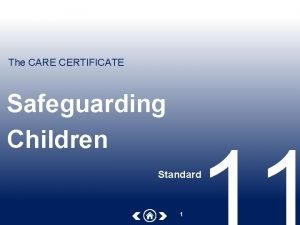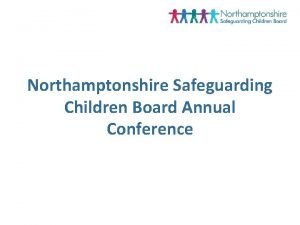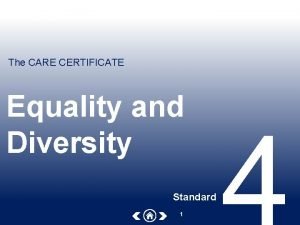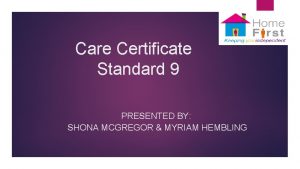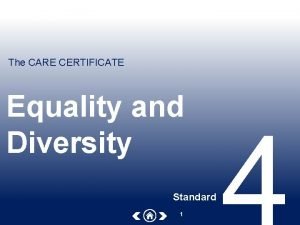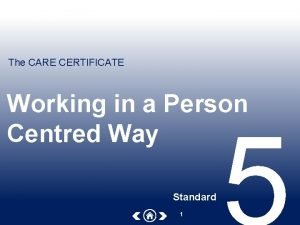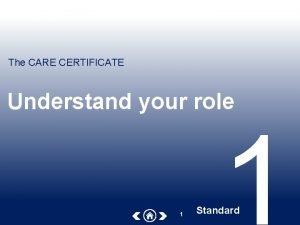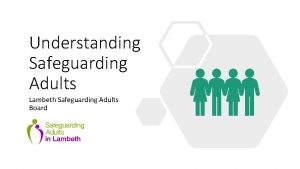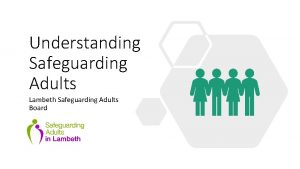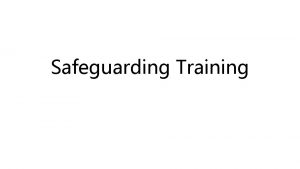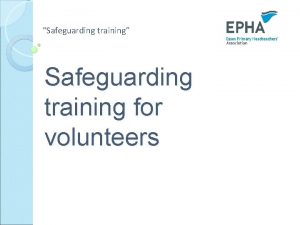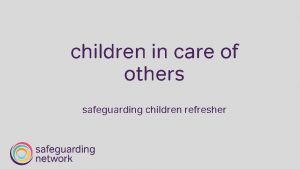The CARE CERTIFICATE Safeguarding Children Standard 1 Learning












- Slides: 12

The CARE CERTIFICATE Safeguarding Children Standard 1

Learning outcomes 11. 1 To be able to recognise potential indicators of child maltreatment – physical, emotional, sexual abuse and neglect including radicalisation, child trafficking and female genital mutilation (FGM) 11. 2 To be able to understand the impact a parent/carer’s physical and mental health can have on the wellbeing of a child or young person, including the impact of domestic violence 11. 3 To be able to understand the importance of children’s rights in the safeguarding/child protection context 11. 4 To know what action to take if you have concerns, including to whom you should report your concerns and from whom to seek advice 11. 5 To be able to demonstrate an understanding of the risks associated with the internet and online social networking 11. 6 To be able to understand the basic Standard legislation (Children Acts 1989, 2004 and the Sexual Offences Act 2003). 2

Child protection and safeguarding ■ Child protection and safeguarding is everyone’s responsibility ■ If you come into contact with children in your day-to-day work you have a duty to promote their welfare and protect them from harm and abuse. Child protection and safeguarding Safeguarding is preventative and involves promoting the welfare of children by protecting them from harm and recognising the risks to their safety and security. Child protection is the activity of protecting children who are suffering or may be likely to suffer from significant harm as a result of abuse or neglect. 3

What is child abuse? Physical abuse This is any abuse where a child is physically harmed or injured such as punching, hitting, slapping, biting, burning, hair pulling Emotional abuse This means a child’s emotional needs are not being met. They may be made to feel inadequate or feel unloved and insecure Sexual abuse This could involve sexual acts, being made to watch sexual acts, being shown pornography or being sexually exploited Neglect The failure to meet the basic needs of the child e. g. providing insufficient food and clothing, poor parenting Children and young people are taught and encouraged to adopt Radicalisation extreme views based on political, social or religious beliefs. 4

What is child abuse? Child trafficking This means recruiting, moving or receiving a child through force, trickery or intimidation to take advantage of them Female genital The removal, constriction or disfigurement of a girl’s labia or clitoris for non-medical reasons mutilation 5

Parental/carer mental and physical health If a parent or carer has a physical or mental health condition this could increase the child’s vulnerability and therefore present a risk to their wellbeing. § Remember, a parent or carer’s health may affect their ability to safeguard, but this is not always the case. Most will be able to care for and safeguard their child, especially with the right support in place. 6

The impact of domestic violence/abuse Seeing or hearing domestic violence is a risk to the child’s physical, emotional and social development ■ Seeing or hearing domestic violence can have a similar effect on children as being emotionally abused ■ The child may feel helpless and may not feel safe Research suggests that: ■ It is likely that aggression could turn towards children present ■ The stress of experiencing violence at home can impair the brain development of babies. 7

Children’s rights You have a duty to promote the rights of all individuals. Children have rights under: ■ The Human Rights Act 1998 ■ The United Nations Convention on the Rights of the Child (UNCRC). The right to life The right to education Freedom from torture or degrading treatment The right of protection from drugs, sexual abuse or any harm to their development The right to live a healthy life Protection from discrimination The right to liberty and security The right to not be separated from their parents unless they are at risk of harm 8

Actions when abuse is suspected or alleged If you are worried about a child: ■ Report your concerns to your manager immediately ■ Make a record of your concerns that is factual and sign and date it ■ If you feel that this process is taking too long, dial 999 and call the police; they can quickly remove a child to somewhere safe ■ Follow your organisation’s safeguarding policies and procedures. These will set out clearly how workers are to act when abuse is suspected or alleged. 9

Whistleblowing ■ Your manager will follow agreed ways of working for reporting and investigating your concerns; this may mean contacting relevant agencies ■ If your concerns are not acted upon you must report them to a senior manager ■ Further advice and support can come from the NSPCC or children’s services at your local council. 10

Internet and online social networking The internet gives access to endless information making it a valuable tool. It is also a potential risk to safety. It is important to monitor what a child sees, shares and is exposed to. Risks to child safety and wellbeing include: ■ Risk of exposure to sexual predators (e. g. in chatrooms) ■ Risk of exposure to pornography (e. g. in chatrooms) ■ Risk of exposure to radicalisation. (e. g. in chatrooms) ■ E-bullying on networks such as Twitter and Facebook. 11

Legislation relating to safeguarding and protecting children Key pieces of legislation include: ■ The Children Act 1989 ■ The Children Act 2004 ■ The Sexual Offences Act 2003 ■ The Care Act 2014 ■ The Children and Families Act 2014. 12
 Safeguarding children care certificate
Safeguarding children care certificate Care certificate standard 9 answers
Care certificate standard 9 answers Birmingham safeguarding adults board
Birmingham safeguarding adults board Northamptonshire safeguarding board
Northamptonshire safeguarding board Equality and diversity care certificate
Equality and diversity care certificate Duty of care outcome care certificate
Duty of care outcome care certificate Standard 9 care certificate
Standard 9 care certificate Care certificate standard 4
Care certificate standard 4 Hip fracture care clinical care standard
Hip fracture care clinical care standard Primary care secondary care tertiary care
Primary care secondary care tertiary care Cuadro comparativo e-learning b-learning m-learning
Cuadro comparativo e-learning b-learning m-learning Work in a person centred way care certificate
Work in a person centred way care certificate Responsibilities to the individuals you support
Responsibilities to the individuals you support
